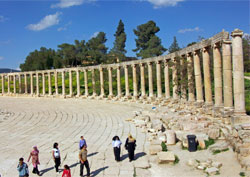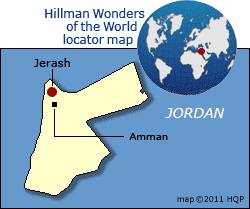Jerash
 Why Jerash
is special
Why Jerash
is specialJerash is one of the world's best preserved and most interesting Roman Cities beyond Italy.
Top 5 Jerash must-sees
South Theatre
For being 2,000 years old, this theatre is remarkably good conditioned. South Theatre seats 3,000 and has an architecturally stunning stage back drop. The venue is still used today for stage performances.
Cardo
Jerash's long main drag is arrestingly lined on both sides with soaring columns dating back to the first century. "Colonnaded Street" is Cardo's English name.
Oval Plaza
This public forum is gracefully encircled by more than 150 columns arrayed in arcs.
Hippodrome
Though much of the original seating is gone, the track itself remains intact, evoking visions of ancient chariot races cheered on by nearly 15,000 roaring spectators.
Nymphaeum
This embellished public fountain was dedicated to the mythological Nymphs.
Top runners-up (alphabetical):
Archaeological Museum, Hadrian's Arch, North Theatre, South Gate, and Temple of Artemis.
More Jerash tips and insights
How to pronounce
Jerash = juhr-ahsh
History in brief
- Archaeological evidence indicates that the site was inhabited for at least 5,000 years. Some experts place the date at 6,500 years.
- Jerash didn't begin to prosper until after Alexander the Great conquered it in the 4th century BC.
- It reached its economic peak during its days as a Roman provincial city from 63 BC to several centuries later.
- It was downhill from there. Once-prospering Jerash was eventually abandoned and buried in sand. It was rediscovered in the early 1800's and excavations began a century later.
The site is only 48 kilometers (30 miles) north of Jordan's capital.
Location in Jordan



